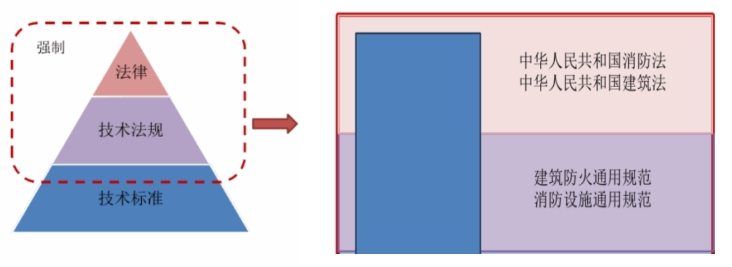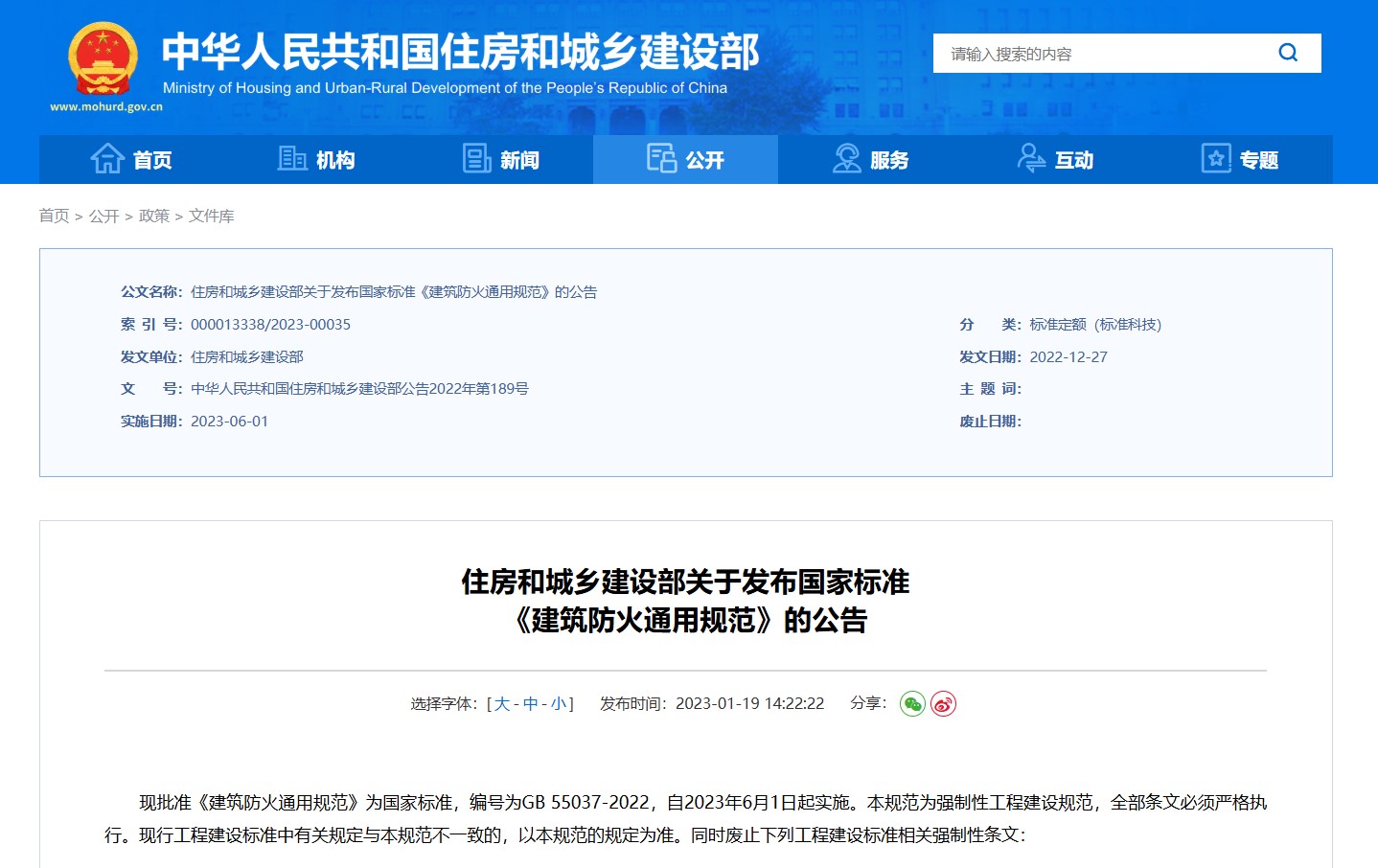New interpretation of "General Code for Fire Protection of Buildings" (GB 55037-2022)
Systematic positioning of the specification
In order to adapt to the common rules of international technical regulations and technical standards, since 2016, the Ministry of Housing and Urban-Rural Development has successively issued documents such as "Opinions on Deepening the Reform of Engineering Construction Standardization Work", proposing the long-term goal of the government formulating mandatory standards and social groups formulating voluntary adoption standards, and clarifying the reform task of gradually replacing the scattered mandatory provisions in the current standards with full-text mandatory engineering construction specifications, and gradually forming a "technical regulations" system consisting of technical provisions in laws, administrative regulations, and departmental regulations and full-text mandatory engineering construction specifications. Since 2021, 40 full-text mandatory engineering construction specifications have been approved and issued. "General Code for Building Fire Protection" (GB 55037-2022) (hereinafter referred to as the specification) is one of them.
"Technical Regulations" System Diagram
Release of Specifications
On January 19, 2023, the Ministry of Housing and Urban-Rural Development of the People's Republic of China announced the release of Document No. 189 at the end of 2022, approving the "General Code for Fire Protection of Buildings" as a national standard, numbered GB 55037-2022, and implemented from June 1, 2023. This specification is a mandatory engineering construction specification, and all provisions must be strictly enforced.

Main contents of the specification
The specification applies to all kinds of above-ground and underground industrial and civil buildings, various types of housing construction, rail transit projects, urban traffic tunnel projects, civil air defense projects of highway tunnel projects, gas and hydrogen stations, pipe corridors or common trenches and cable tunnels and other municipal projects and facilities, various production equipment, towers and silos and other structures, but not to flammable gas and liquid storage tanks or storage tank areas, flammable material yards, container yards, nuclear power projects and their buildings, military buildings and projects, mining projects, explosives and fireworks and other pyrotechnics buildings and projects.
The main contents of the specification are:
1. The objectives and functions of building fire protection, and basic provisions for fire rescue facilities;
2. General requirements for the overall layout of buildings, and the fire protection distance between industrial buildings and civil buildings and basic requirements for fire rescue;
3. Basic requirements for building layout and fire separation;
4. Function and performance requirements for fire resistance of building structures;
5. Function and performance requirements for fire protection of building structures and decoration;
6. Function and performance requirements for safe evacuation and refuge facilities;
7. Function and performance requirements for fire protection facilities;
8. Function and performance requirements for fire protection of heating, ventilation and air conditioning systems;
9. Function and performance requirements for electrical fire protection;
10. Function and performance requirements for fire protection of building construction;
11. Function and performance requirements for fire protection of building use and maintenance.
Changes in the main technical requirements of the specification
1. The main goals of building fire protection and the functional goals and main performance requirements of each subsystem in the building fire protection system are clarified;
2. The bottom line requirements of each fire protection subsystem are clarified;
3. The principles for determining important fire protection technical measures such as fire separation distance, fire zoning division, evacuation distance, and fire protection facility setting are clarified;
4. The fire separation distance in crowded places is adjusted;
5. The principles for determining the fire protection standards for the renovation of existing buildings and the fire protection requirements for densely populated areas of existing buildings are clarified;
6. The requirements for fire rescue facilities are systematically improved;
7. The requirements for the setting of personnel evacuation and refuge facilities are improved and strengthened;
8. The structural fire resistance requirements are strengthened, and the requirements for verification are clarified. Calculate or verify the fire resistance of building structures;
9. Expand the scope of automatic fire alarm systems in civil buildings;
10. Clarify the basic functions, performances and basic fire resistance requirements of various fire doors, fire windows and fire glass walls in different locations;
11. Adjust the requirements for fire partitions and safety exits in warehouse buildings;
12. Adjust the requirements for boilers and diesel generator rooms;
13. Appropriately improve the fire protection requirements for buildings with a height of more than 100m, 150m and 250m, and strengthen the requirements for the protection and identification of fire protection facilities;
14. Add the basic requirements for fire communication and command systems;
15. Improve other details.
Relationship with current technical standards
The notice abolished the mandatory provisions of the corresponding standards, including the provisions and their mandatory nature. In the transition stage when the relevant standards have not been revised, only their mandatory nature will be abolished. During the implementation process: when the original standard provisions do not repeat, contradict or are not lower than the provisions of the specification, the original provisions will be retained but recommended; when the original standard provisions repeat, the general specification will be directly quoted or deleted when revising the relevant technical standards; when the original provisions contradict, are inconsistent or lower than the provisions of the specification, the original provisions will be abolished.
Matters needing attention during implementation
For fire protection facilities and fire protection technologies not clearly specified in the specification, the design, construction, acceptance, use and maintenance requirements should be determined according to the basic requirements of Chapter 2 of the specification and the functions, performance requirements and technical standards of the corresponding fire protection facilities or building fire protection systems during construction, use and maintenance.
Whether the fire protection facilities or fire protection technologies installed in a construction project meet the requirements of the specification should be determined according to the basic requirements of the relevant fire protection facilities or fire protection technologies in the specification, and the functional objectives of the fire protection facilities or fire protection technologies should be set according to the performance and functions they can have, and the corresponding technical performance and related parameter indicators should be determined on this basis.
The release of this new specification marks that my country's building fire protection standards have entered a new stage of being more scientific and practical, which will greatly improve the


